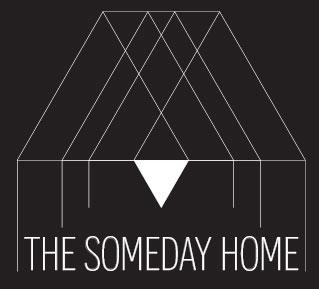Before we finished our living room, the item in my home that always got the most comments was my windmill, but coming in at a close second was the over-sized family portrait I transferred onto wood. Everyone who set foot in my living room commented on it, and it was definitely one of my favorite things. I mean, what’s not to love? It’s wood, it’s weathered, and it’s got some pretty good looking people on it (but I might be biased there).

I took it down during our renovation, and I never put it back up because it really needed to be updated. My laugh lines are deeper, the boys are way taller, and if you look *really* closely, you’ll notice that we’re missing a kid. That being said, I’m gonna level with you: I was not itching to do it again, and I probably wouldn’t have, if it weren’t missing sweet Georgia Ann. This project was relatively affordable and easy to complete, but the time I spent trying to center the large portrait and ensure it was straight was… well, my personal version of hell.
I will say, though, that the end product is definitely worth the frustrating process, and if you aren’t trying to tackle a picture as large as mine, it probably won’t be so bad.
But, if you need any further motivation, I mean, just look at it!
Before I get into the details of the project, I want to give a shoutout to my amazing family photographer, Crystal Kruse of Kruse PhotoGraphics. She’s been photographing my family for 6 years now, and we are always blown away by her results. If you’re ever in the Sioux Falls area and you need a photographer, she’s your girl!
This project takes about 24-48 hours and $12-50 (depending upon what you’ve got for scrap wood, the size of your photograph, and how much your printer charges). Are you ready?
You’ll need:
- Wood- get creative here! I used a piece of plywood, but you could use whatever you’ve got lying around. 1 x 4’s planked together, a 1 x 12 cut down to size… whatever fits your space! Feel free to paint or stain your wood, if you like, but keep in mind that a darker color might not allow your photograph to show up well.
- A photo transferring fluid- I’ve used a couple of different ones. The first time I did this, I used Liquitex Gel Medium. This most recent time, I used ModPodge Transfer Medium. I was told that the ModPodge Transfer medium would let more wood grain show through, but honestly, I wasn’t happy with my experience this time… I’ll get into that in a minute. I definitely had an easier time with the Liquitex.
- Your photograph, printed on paper with a laser printer
Step 1: Reverse your picture
Unless you want your picture to end up backward on your wood, you’ll want to reverse it. This is easily done in Photoshop or just about any free photo editing software.
Step 2: Print your picture
You can either have your photo printed at a print shop or in your own home if you have a laser printer. Because of the size of mine (24 x 36″), I opted to have it printed at my local print shop. I’ve heard you can use places like Staples and Office Max and ask for an “engineering” print, but I can’t speak to the quality since I’ve never done it that way.
Step 3: Spread the transfer fluid
Spread your transfer fluid onto your wood, coating it evenly. This was the beginning of the mini OCD attack for me…
The first time I did this project, I used the Liquitex Gel Medium. It went on pretty evenly, and my biggest concern was covering the entire area quickly enough so that none of it dried before my next step.
The ModPodge was much thicker and more difficult to spread. I had trouble getting all of my board covered, and then when I got to my next step, I had some real trouble getting my image flat.

Step 4: Place your image
Place your image face-down on your board, making sure it’s aligned correctly. By this time, I was pretty much in full-blown anxiety mode, but luckily I had a set of helpful hands from my crafty 7-year-old to make this part a little easier. This step would be much easier and less panic-inducing if you’re doing a smaller-scale project.
Step 5: Let it dry overnight
Aside from the eagerness and anticipation of wanting to see the final results, this part is probably the easiest. Turn on Netflix, pour yourself a glass of wine, and chill out.
Step 6: Wet and peel
After 24 hours has passed (or more, if you get really busy and forget about your projects like I do sometimes), you can begin to carefully peel the paper off. This works best if you use a spray bottle to get the paper wet and then use a towel to gently rub the back part of the paper off, being careful not to rub too hard. You just want to remove the top layer of the paper. If you scrub too hard, you’ll risk removing your image.
This process can be kind of a tedious one, but don’t lose heart! You’re almost done!

Step 7: Seal and finish
Once you’ve got your paper removed, you are ready to finish it. I finished our first photo board with a coat of Liquitex and then a light once-over with a medium-dark stain to add some warmth and rustic-goodness. The second time around, I lightly brushed on a coat of vegetable oil, and then applied another coat of ModPodge to seal it.
Final results
I definitely preferred the Liquitex that I used the first time around. Because my ModPodge was thicker in some areas, I had some problems with my paper rippling and not laying totally flat, which resulted in a strange, tiger stripe-y pattern. I really loved the wood grain coming through in the sky area of the background, but I just wasn’t pleased with the overall results.

Luckily, Smallwoods was running a killer sale, so I had no qualms with tossing my failed project in the scrap wood bin and instead having a beautiful, wood framed sign board printed and sent to me. Their prices were incredible and I couldn’t be happier with the quality!


